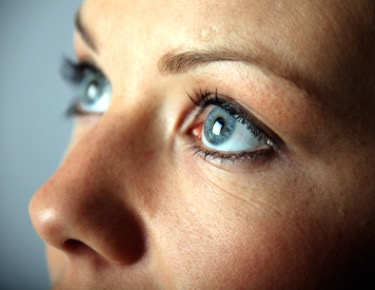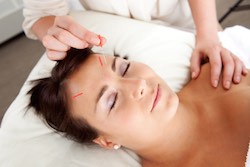Acupuncture benefits patients with dry eyes. Optical coherence tomography with biomicroscopy demonstrates that acupuncture significantly reduces dry eyes for patients with lipid tear deficiency (LTD) and non-Sjögren syndrome (Non-SSDE) related dry eyes. Acupuncture successfully increased abnormally reduced tear meniscus parameters including tear meniscus height, tear meniscus depth, and tear meniscus area.  The tear meniscus is a thin film of tear fluid that, when absent, indicates dry eyes. The researchers note that acupuncture “provided a measurable improvement of the tear meniscus dimensions….”
The tear meniscus is a thin film of tear fluid that, when absent, indicates dry eyes. The researchers note that acupuncture “provided a measurable improvement of the tear meniscus dimensions….”
The study employed the highest standards using a randomized parallel-group intervention type of clinical study with a sample size of 96 human dry eye patients. A total of 44 patients were in the acupuncture group and 52 patients were in the control group. The acupuncture group received acupuncture treatments three time per week for four weeks for a total of 12 acupuncture treatments per patient. Participants did not use any other type of therapy to treat dry eyes. Acupuncture points selected for use in the study were consistent with Traditional Chinese Medicine (TCM) theory and included:
- Jingming (BL1)
- Cuanzhu (BL2)
- Yangbai (GB14)
- Sizhukong (SJ23)
- Taiyang (Extra1)
- Sibai (ST2)
- Hegu (LI4)
- Taichong (LR3)
- Guangming (GB37)
- Sanyinjiao (SP6)
- Fengchi (GB20)
Acupuncture needles were manually inserted and the de qi response was elicited. Total needle retention time was 30 minutes. An RTVue-100 optical coherence tomography device, manufactured by a Fremont (California) company, non-invasively captured eye cross-section images using light waves. This device was the first FDA cleared spectral domain optical coherence tomography unit capable of capturing both corneal and retinal imaging.
The researchers note, “A measurable increase in tear meniscus dimensions was evident after 4 weeks of acupuncture treatment in the Non-SSDE and LTD patients, but not in the SSDE patients.” The researchers note that SSDE (Sjögren syndrome dry eye) resistance to improvement may be due to long-term chronic inflammatory stimulation of the lacrimal glands resulting in acinar and ductular cell death and functional impairment. The researchers add that “present results provide an evidence for clinical application of acupuncture to treat dry eye and select the appropriate treatment strategy for different types of dry eye.”

The researchers used both local and distal acupoints in the acupuncture point prescription. GB14 is located on the forehead, 1 cun above the middle of the eyebrow on a line directly above the pupil. This TCM classic acupoint is indicated for benefitting vision, eyelids, and is also indicated for the treatment of supraorbital neuralgia. According to TCM theory, it is the meeting point of the gall bladder, sanjiao, stomach, large intestine and yang linking channels. GB14 point is indicated for treating eye conditions including night blindness, short sightedness, lacrimation disorders, and eye pain.
GB37 is a distal point, located on the lower leg, used in the study. This point is 5 cun directly above the tip of the external malleolus, on the anterior border of the fibula. It is another classic TCM acupoint for the treatment of eye disorders including visual disturbances. This acupoint is also used to regulate the liver. According to TCM theory, this point is a Luo-connecting point and is indicated for the treatment of eye pain, night blindness, knee pain, and atrophy of the lower leg.
All of the acupuncture points were applied by an acupuncturist with at least 5 years of clinical experience. In addition, all of the acupuncture points in the study are consistent with TCM theory for the treatment of eye disorders. The researchers have added the benefit of sophisticated instrumentation to verify the efficacy of acupuncture for the treatment of dry eyes. Now, science combines with ancient medicine to objectively measure data points indicating positive patient outcomes for patients with dry eyes.
Reference:
Lin, Tong, Lan Gong, Xiaoxu Liu, and Xiaopeng Ma. "Fourier-Domain Optical Coherence Tomography for Monitoring the Lower Tear Meniscus in Dry Eye after Acupuncture Treatment." Evidence-Based Complementary and Alternative Medicine 2015 (2015).


